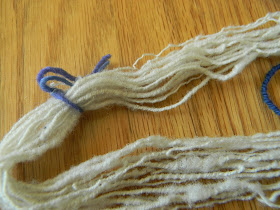Combed Preparation:
With a staple length of just over 3 inches, I knew I was tempting fate by trying to comb the Targhee locks in order to spin a worsted prep. The good news: this batch of fiber combed surprisingly easily, with very few neps or bumps.
I went to my Ashford Kiwi wheel and chose to use the fast flyer to test it. I started with the 11:1 ratio. Here is where I ran into my first problem. I would get the fiber to take up on the leader and start spinning, but then the fiber itself would fall apart. It wasn't getting enough twist. So I took the brake band to its loosest tension, and tried it on the 14:1 ratio. Still a no go. It just wasn't working.
I tried to spin worsted, but my dears, this fiber simply calls for a woolen prep. It needs the fibers to be a little wonky in order to spin properly. I couldn't bear to show you the mess this created. No pictures of attempted worsted prep.
Carded Preparation:
I used my Ashford 72 TPI hand cards for the prep on this. I didn't want to risk tearing the fiber by using my drum carder (although for processing lots of fiber, drum carding is the way to go...)
Each little rolag carded beautifully. I will admit that there was a bit of VM in the fiber, so I would pick out the big pieces as I carded. It took about 3 passes to get a sufficiently smooth prep.
Look at the little clouds! You can still see the crimp all willy-nilly in there. I was hoping for a springy yarn because of this.
Sample 1:
I started again on my 14:1 fast flyer. The brake band was still almost off. And let me tell you, the fiber loved it. It spun so easily with a short backward draw.
It was easy to pick out the remaining bits of veggie matter as I went, and the fiber was a joy to spin. As I spun, I held a little more tightly on the fiber, to stretch out the crimps, in order to get a springier yarn. Once the crimp relaxed into the yarn, they would offer a bit more spring.
Sample 1 Specs:
-Spun on Ashford Kiwi
-Woolen Spun
-Short backward draw
-Singles spun 14:1
-Navajo Plied 11:1
-16-24 WPI
-lace-fingering weight
-approx. 15 yds
The yarn was finished with a warm bath in Soak wash, then thwacked to finish (a technical term). Once dry, the yarn was springy, and would make a good sweater (lots of elasticity, so it would bounce back). There were spots where the yarn itself was overspun, but all in all, it was a good first sample.
Sample 2:
This time I started the wheel on its 11:1 ratio, with every intention of seeing if ratios would affect the amount of air introduced into the yarn. The fiber still drafted easily, and was easy to manage. Almost to interference was required to spin a nice fluffy yarn.Sample 2 Specs:
-Spun on Ashford Kiwi
-Woolen style, short backward draw
-Singles spun 11:1
-Navajo plied 7.5:1
-14-22 WPI
-Closer to fingering weight
-Approx. 24 yards
After its bath and requisite thwacking, this yarn dried into a beautiful skein. It seems a little whiter compared to the first sample, which I think has more to do with the space between the fibers than any actual color differences.
This skein is actually more bouncy than the other (another result of air introduction, I think...) and softer, I think it would make a great hat. Or a really cool shawl.
Summary:
This fiber wanted to be spun woolen, to take advantage of its springy nature and short staple length. I think the best sample was the fingering weight sample. Laceweight seemed to squash most of the air out of it. It would most likely be good as a three ply worsted weight even. When spinning, I need to remember that, due to the crimps per inch, I should stretch out the crimps in order to take advantage of the spring factor of the fiber.
This fiber wants to be springy, lofty, and bouncy. So prep and spinning should follow suit. The yarn itself will not shine the way that Cotswold does, with a distinct shine, but it will have a sheen, much like the white on an opal.











No comments:
Post a Comment